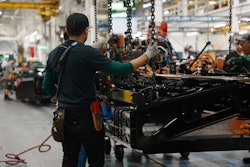Arguably the best selling point to a customer considering retreading today is how rapidly the industry has evolved.
Harvey Brodsky, managing director at the Retread Tire Association (RTA), says commercial retread tires on North American highways today have a lower average adjustment rate than new tires, and have for a number of years. Adjustment rate is defined as the percentage of faulty tires produced relative to the total number of a tires produced, i.e. how many tires go bad.
Brodsky says Tier 1 North American new commercial tire suppliers have a cumulative adjustment rate of approximately 1 percent. RTA’s top manufacturers regularly post an adjustment rate of less than 1 percent. The reason for that, Brodsky says, is the evolution of retreading.
The retread tires available in the market today aren’t just new treads glued to an older casing. They are intricately tested, repaired and assembled meet and exceed new tire standards.
“Retread technology has improved product quality,” says Phil Boarts, product category manager, retread at Michelin Truck Tires. “Compounds, siping, tread design, inspection equipment and processes are all areas where great strides have been made in technology.”
Brodsky says the technology being used in today’s top retreading businesses are specifically designed to weed out bad tires and make sure only the best casings are retreaded — keeping adjustment rates low and ensuring high-quality products.
A shearography machine is a prime example of how technology has improved the retreading industry. Guy Walenga, director, engineering, commercial products and technologies at Bridgestone, says the machine works “like an x-ray,” and reveal cracks and imperfections in a tire casing invisible to the naked eye.
“It’s like giving a tire a CAT scan or an MRI,” adds Brodsky. “It allows an inspector to look through the sidewall of a casing and see if there are deficiencies inside that might need to be repaired or prohibit retreading.”
Walenga says Bridgestone’s Bandag retreading business also uses a Non-Destructive Tire analyzer (NDT) after shearography testing. The NDT sends electricity though the tire and allows the manufacturer to identify pinholes and other microscope damage.
And both tests are just individual steps in a multi-point inspection all casings must pass to even be considered for retreading.
“Retreading a truck tire is a multiple-step manufacturing process performed by highly-trained technicians,” says Todd Labbe, general manager, commercial retread at Goodyear Commercial Tire Systems.
Click here to read Part III: Retread tires offer financial, environmental benefit







